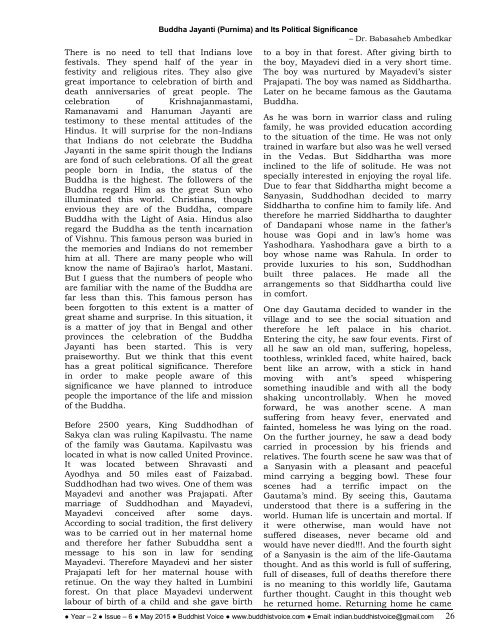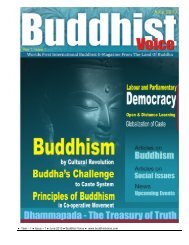BV - May 2015 Yr 2 Issue 6 E
Create successful ePaper yourself
Turn your PDF publications into a flip-book with our unique Google optimized e-Paper software.
Buddha Jayanti (Purnima) and Its Political Significance<br />
– Dr. Babasaheb Ambedkar<br />
There is no need to tell that Indians love<br />
festivals. They spend half of the year in<br />
festivity and religious rites. They also give<br />
great importance to celebration of birth and<br />
death anniversaries of great people. The<br />
celebration of Krishnajanmastami,<br />
Ramanavami and Hanuman Jayanti are<br />
testimony to these mental attitudes of the<br />
Hindus. It will surprise for the non-Indians<br />
that Indians do not celebrate the Buddha<br />
Jayanti in the same spirit though the Indians<br />
are fond of such celebrations. Of all the great<br />
people born in India, the status of the<br />
Buddha is the highest. The followers of the<br />
Buddha regard Him as the great Sun who<br />
illuminated this world. Christians, though<br />
envious they are of the Buddha, compare<br />
Buddha with the Light of Asia. Hindus also<br />
regard the Buddha as the tenth incarnation<br />
of Vishnu. This famous person was buried in<br />
the memories and Indians do not remember<br />
him at all. There are many people who will<br />
know the name of Bajirao’s harlot, Mastani.<br />
But I guess that the numbers of people who<br />
are familiar with the name of the Buddha are<br />
far less than this. This famous person has<br />
been forgotten to this extent is a matter of<br />
great shame and surprise. In this situation, it<br />
is a matter of joy that in Bengal and other<br />
provinces the celebration of the Buddha<br />
Jayanti has been started. This is very<br />
praiseworthy. But we think that this event<br />
has a great political significance. Therefore<br />
in order to make people aware of this<br />
significance we have planned to introduce<br />
people the importance of the life and mission<br />
of the Buddha.<br />
to a boy in that forest. After giving birth to<br />
the boy, <strong>May</strong>adevi died in a very short time.<br />
The boy was nurtured by <strong>May</strong>adevi’s sister<br />
Prajapati. The boy was named as Siddhartha.<br />
Later on he became famous as the Gautama<br />
Buddha.<br />
As he was born in warrior class and ruling<br />
family, he was provided education according<br />
to the situation of the time. He was not only<br />
trained in warfare but also was he well versed<br />
in the Vedas. But Siddhartha was more<br />
inclined to the life of solitude. He was not<br />
specially interested in enjoying the royal life.<br />
Due to fear that Siddhartha might become a<br />
Sanyasin, Suddhodhan decided to marry<br />
Siddhartha to confine him to family life. And<br />
therefore he married Siddhartha to daughter<br />
of Dandapani whose name in the father’s<br />
house was Gopi and in law’s home was<br />
Yashodhara. Yashodhara gave a birth to a<br />
boy whose name was Rahula. In order to<br />
provide luxuries to his son, Suddhodhan<br />
built three palaces. He made all the<br />
arrangements so that Siddhartha could live<br />
in comfort.<br />
One day Gautama decided to wander in the<br />
village and to see the social situation and<br />
therefore he left palace in his chariot.<br />
Entering the city, he saw four events. First of<br />
all he saw an old man, suffering, hopeless,<br />
toothless, wrinkled faced, white haired, back<br />
bent like an arrow, with a stick in hand<br />
moving with ant’s speed whispering<br />
something inaudible and with all the body<br />
shaking uncontrollably. When he moved<br />
forward, he was another scene. A man<br />
suffering from heavy fever, enervated and<br />
Before 2500 years, King Suddhodhan of fainted, homeless he was lying on the road.<br />
Sakya clan was ruling Kapilvastu. The name On the further journey, he saw a dead body<br />
of the family was Gautama. Kapilvastu was carried in procession by his friends and<br />
located in what is now called United Province. relatives. The fourth scene he saw was that of<br />
It was located between Shravasti and a Sanyasin with a pleasant and peaceful<br />
Ayodhya and 50 miles east of Faizabad. mind carrying a begging bowl. These four<br />
Suddhodhan had two wives. One of them was scenes had a terrific impact on the<br />
<strong>May</strong>adevi and another was Prajapati. After Gautama’s mind. By seeing this, Gautama<br />
marriage of Suddhodhan and <strong>May</strong>adevi, understood that there is a suffering in the<br />
<strong>May</strong>adevi conceived after some days. world. Human life is uncertain and mortal. If<br />
According to social tradition, the first delivery it were otherwise, man would have not<br />
was to be carried out in her maternal home suffered diseases, never became old and<br />
and therefore her father Subuddha sent a would have never died!!!. And the fourth sight<br />
message to his son in law for sending of a Sanyasin is the aim of the life-Gautama<br />
<strong>May</strong>adevi. Therefore <strong>May</strong>adevi and her sister thought. And as this world is full of suffering,<br />
Prajapati left for her maternal house with full of diseases, full of deaths therefore there<br />
retinue. On the way they halted in Lumbini is no meaning to this worldly life, Gautama<br />
forest. On that place <strong>May</strong>adevi underwent further thought. Caught in this thought web<br />
labour of birth of a child and she gave birth he returned home. Returning home he came<br />
● Year – 2 ● <strong>Issue</strong> – 6 ● <strong>May</strong> <strong>2015</strong> ● Buddhist Voice ● www.buddhistvoice.com ● Email: indian.buddhistvoice@gmail.com 26



